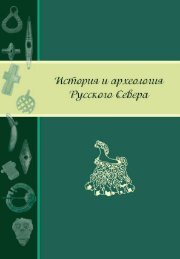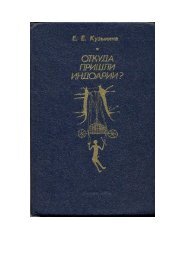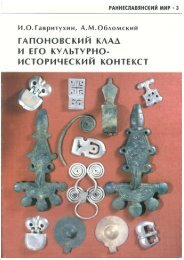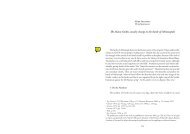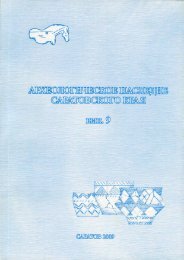The Archaeology of Celtic Art
The Archaeology of Celtic Art
The Archaeology of Celtic Art
- No tags were found...
Create successful ePaper yourself
Turn your PDF publications into a flip-book with our unique Google optimized e-Paper software.
LATER BRONZE AGE AND HALLSTATT ORIGINSdrinking cup. Beaten bronze cups in a succession <strong>of</strong> variant forms are characteristic <strong>of</strong>the Urnfield late Bronze Age and adjacent regions <strong>of</strong> Northern Europe, and have beenclassified into a typological sequence named after the hoards or rich burials in whichthey are found. Friedrichsruhe and Fuchsstadt cups, with decorated variants such asthose from the Dresden-Dobritz hoard (Pl. 2a), date from the end <strong>of</strong> Bronze D throughHallstatt A1 and A2 respectively, and for Hallstatt B, successively Jenosovice cups,Haslau-Regelsbrunn cups and Stillfried-Hostomice cups are typical. <strong>The</strong> bucket itself,also found in a variety <strong>of</strong> different forms, was for mixing and serving the alcoholicbeverage. Its ceremonial or ritual associations are suggested by the inclusion <strong>of</strong> sun-discand bird symbolism in repoussé, as we have seen, on buckets like the virtually identicalpair from Hajdúböszörmény and Unterglauheim. Both these hoards also includedexamples <strong>of</strong> another class <strong>of</strong> beaten bronze vessel, a hemispherical bowl with twin,looped handles attached by means <strong>of</strong> doubled T-shaped plates riveted to the body <strong>of</strong>the bowl. This distinctive type continues in modified form into the Hallstatt Iron Age,its distribution extending well beyond the primary Urnfield zone. A simpler variantwith single handle and A-shaped attachments has a more limited distribution inUrnfield Central Europe.In Atlantic Europe too, buckets and cauldrons were used for communal feasting anddrinking in the late Bronze Age, though without the range <strong>of</strong> accessory vessels thattypifies the hoards <strong>of</strong> Central and Northern Europe. Beaten bronze buckets occurwidely from at least the Hallstatt A2 phase from Transylvania through the Danube,in Italy and extending as far as Northern Europe, in a range <strong>of</strong> variant types. <strong>The</strong> Irishand British buckets were related to the later Urnfield Kurd Eimer (von Merhart, 1952,29–33), but with the significant addition <strong>of</strong> the loose ring-handles which Hawkes andSmith (1957) believed were assimilated from the Atlantic cauldrons. <strong>The</strong> cauldronsthemselves were not characteristic <strong>of</strong> Central Europe, though they had their counterpartsin the Mediterranean and Middle East. Formerly supposed to derive from theseMediterranean antecedents, the Atlantic cauldrons are now dated from the early firstmillennium bc, and regarded as an independent western development. In CentralEurope, the smaller hemispherical bowls with cross-handle attachments and relatedtypes persisted into the Iron Hallstatt C phase, before being superseded in Hallstatt Dby a larger form <strong>of</strong> hemispherical cauldron with inturned rim.<strong>The</strong> significance <strong>of</strong> these typological variations in terms <strong>of</strong> prestigious aristocraticfeasting rituals or communal celebrations is unclear. To argue that the immense volume<strong>of</strong> the Atlantic cauldrons (Figure 2.6b), compared to the smaller vessels <strong>of</strong> theCentral European Urnfield or Hallstatt C assemblages, reflects communal festivities asopposed to rituals <strong>of</strong> a more selective aristocratic elite, might be unduly simplistic.But the fact remains that bronze vessels associated with feasting and drinking area notable component <strong>of</strong> the archaeological assemblage from the beginning <strong>of</strong> thelate Bronze Age through to the end <strong>of</strong> the pre-Roman Iron Age and beyond, andnot exclusively in regions that by any definition might be described as ‘<strong>Celtic</strong>’ or‘proto-<strong>Celtic</strong>’.Personal ornament and dressThroughout the Urnfield zone, and indeed in the cognate late Bronze Age cultures <strong>of</strong>Northern and Atlantic Europe, personal ornaments are an important component <strong>of</strong>32



